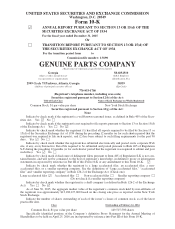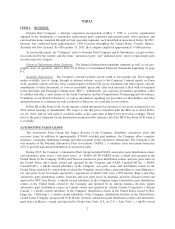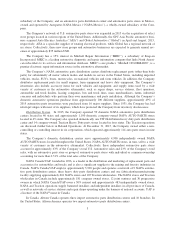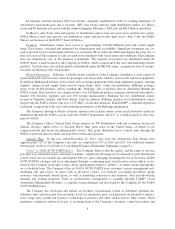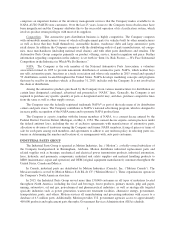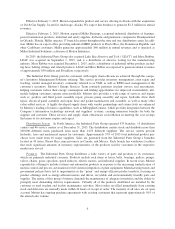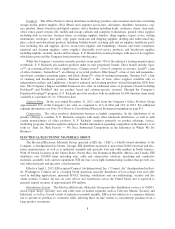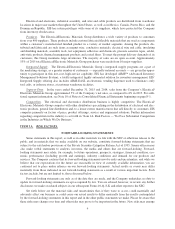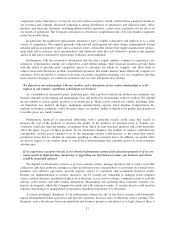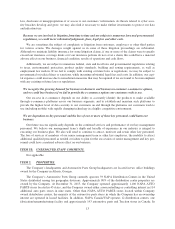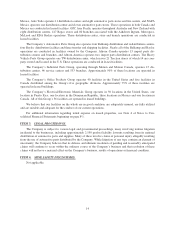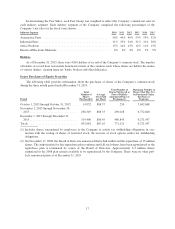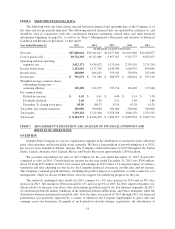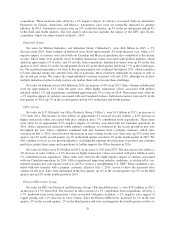Napa Auto Parts 2015 Annual Report Download - page 17
Download and view the complete annual report
Please find page 17 of the 2015 Napa Auto Parts annual report below. You can navigate through the pages in the report by either clicking on the pages listed below, or by using the keyword search tool below to find specific information within the annual report.• changes in travel patterns, which may cause consumers to rely more on other transportation;
• restrictions on access to diagnostic tools and repair information imposed by the original vehicle manu-
facturers or by governmental regulation, as consumers may be forced to have all diagnostic work, repairs
and maintenance performed by the vehicle manufacturers’ dealer networks; and
• the economy generally, which in declining conditions may cause consumers to defer vehicle maintenance
and repair and defer discretionary spending.
With respect to our industrial parts group, the primary factors are:
• the level of industrial production and manufacturing capacity utilization, as these indices reflect the need
for industrial replacement parts;
• changes in manufacturing reflected in the level of the Institute for Supply Management’s Purchasing
Managers Index, as an index reading of 50 or more implies an expanding manufacturing economy, while
a reading below 50 implies a contracting manufacturing economy;
• the consolidation of certain of our manufacturing customers and the trend of manufacturing operations
being moved overseas, which subsequently reduces demand for our products; and
• the economy in general, which in declining conditions may cause reduced demand for industrial output.
With respect to our office products group, the primary factors are:
• the increasing digitization of the workplace, as this negatively impacts the need for certain office prod-
ucts;
• the level of unemployment, especially as it relates to white collar and service jobs, as high unemployment
reduces the need for office products;
• the level of office vacancy rates, as high vacancy rates reduces the need for office products; and
• the economy in general, which in declining conditions may cause reduced demand for office products
consumption.
With respect to our electrical/electronic materials group, the primary factors are:
• changes in manufacturing reflected in the level of the Institute for Supply Management’s Purchasing
Managers Index, as an index reading of 50 or more implies an expanding manufacturing economy, while
a reading below 50 implies a contracting manufacturing economy; and
• the economy in general, which in declining conditions may cause reduced demand for industrial output.
Uncertainty and/or deterioration in general macro-economic conditions, including unemployment, inflation
or deflation, changes in energy costs, uncertain credit markets, or other economic conditions, could have a
negative impact on our business, financial condition, results of operations and cash flows.
Our business and operating results have been and may in the future be adversely affected by uncertain
global economic conditions, including domestic outputs, employment rates, inflation or deflation, instability in
credit markets, declining consumer and business confidence, fluctuating commodity prices, interest rates, volatile
exchange rates, and other challenges that could affect the global economy. Both our commercial and retail cus-
tomers may experience deterioration of their financial resources, which could result in existing or potential cus-
tomers delaying or canceling plans to purchase our products. Our vendors could experience similar conditions,
which could impact their ability to fulfill their obligations to us. Future weakness in the global economy could
adversely affect our business, results of operations, financial condition and cash flows in future periods.
We face substantial competition in the industries in which we do business.
The sale of automotive and industrial parts, office products and electrical materials is highly competitive
and impacted by many factors, including name recognition, product availability, customer service, changing
customer preferences, store location, and pricing pressures. Because we seek to offer competitive prices, if our
11


